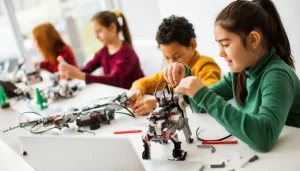The Future of Learning: How the Metaverse is Revolutionizing Education

GBM Insights
- Immersive learning environments in the metaverse can enhance learning experiences through greater engagement and interactivity.
- Collaborative learning in the metaverse can bring together students from different locations and backgrounds to work on projects and share knowledge.
- Virtual classrooms in the metaverse can make education more accessible to students who are unable to attend traditional schools due to financial or geographical barriers.
- The metaverse can promote lifelong learning, allowing people to continue learning and upskilling throughout their lives.
Not just for business
The concept of the metaverse is becoming increasingly popular, with technology companies investing in this space as they believe it could be the next big thing in technology. The metaverse is essentially a virtual space that allows people to interact with each other and with digital objects in a more immersive and lifelike manner than is possible with traditional virtual reality experiences.
Education is one area where the metaverse has the potential to be truly revolutionary. In this article, we will explore how the metaverse is changing the way we learn, and what the future of education might look like in a world where the metaverse is a central part of the learning experience.
How the Metaverse is Changing Education:
The potential of the metaverse to revolutionize education is enormous. Here are some of the ways in which the metaverse is already changing the way we learn:
- Immersive Learning Environments:
One of the most exciting things about the metaverse is the ability to create immersive learning environments. Imagine being able to explore ancient civilizations or travel to other planets without ever leaving your classroom. With the metaverse, this is now possible.
For example, a history class could take place in a virtual version of ancient Rome, where students can walk the streets, visit historical landmarks, and even interact with virtual versions of historical figures. A science class could take place on a virtual spaceship, where students can conduct experiments and explore the universe.
These immersive learning environments have the potential to make learning more engaging and interactive, allowing students to experience things that are impossible in the real world.
- Personalized Learning:
Another benefit of the metaverse is the ability to personalize the learning experience. In traditional classrooms, teachers must teach to the average student, which means that some students may be left behind while others are not challenged enough. In the metaverse, however, each student can have a unique learning experience that is tailored to their individual needs.
For example, a student who struggles with math could be placed in a virtual environment where they can practice math problems in a fun and engaging way. Meanwhile, a student who excels at math could be placed in a more challenging virtual environment where they can solve complex problems and explore advanced concepts.
By personalizing the learning experience, the metaverse has the potential to improve learning outcomes and help students reach their full potential.
- Collaborative Learning:
The metaverse also has the potential to foster collaborative learning. In traditional classrooms, students typically work alone or in small groups. In the metaverse, however, students can collaborate with other students from around the world.
For example, a language class could involve students from different countries practicing their language skills with each other in a virtual environment. A science class could involve students from different schools working together on a virtual experiment.
By fostering collaboration, the metaverse has the potential to teach students important teamwork and communication skills that will benefit them in the workforce and in life in general.
- Access to Information:
One of the biggest benefits of the metaverse is the ability to access information from anywhere in the world. With the metaverse, students can have access to a vast array of educational resources, including virtual libraries, museums, and online courses.
For example, a student in a rural area with limited access to educational resources could attend a virtual class taught by a teacher from a top university in a different part of the world. A student in a developing country could have access to the same educational resources as a student in a developed country.
By providing access to information and educational resources, the metaverse has the potential to level the playing field and ensure that all students have access to quality education.
- Gamification of Education:
The metaverse is also likely to lead to a greater gamification of education. By creating engaging and immersive virtual environments, educators can make learning fun and enjoyable. Gamification can also provide students with instant feedback, allowing them to track their progress and identify areas for improvement.
For example, a language class could involve a virtual game where students must use their language skills to solve puzzles and challenges. A math class could involve a virtual game where students must solve math problems to advance to the next level.
By gamifying education, the metaverse has the potential to make learning more engaging and enjoyable for students of all ages.
Conclusion:
The metaverse is a realm of endless possibilities. While major companies are already flocking to the metaverse to build a more stable and reliable online presence, schools and educational institutions also need to look into adopting the metaverse into their curriculum. Like business, education is an ever-expanding and growing field. Novel methods of teaching and approaching students is key in ensuring a brighter future.
By adopting the metaverse, schools can open themselves up to a different environment, one that is more collaborative, engaging and personalised to cater to each student’s needs. This will not only create a safer and more reliable method of imparting knowledge, but will also help students think for themselves, as the approach becomes more simple and customised. This can lead to student’s developing stronger interests, while also creatively expressing themselves, and thus, ensuring a brighter future. With traditional classrooms and teaching methods quickly becoming obsolete, and other forms of education gaining popularity, it is imperative that educational institutes change the way they approach teaching, lest they become obsolete as well.















